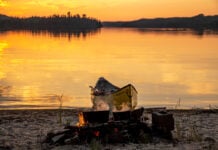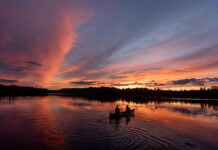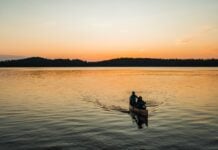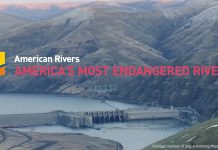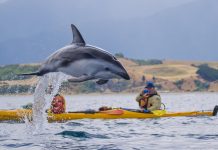Back in 2015, Forest Woodward released a film called The Important Places about floating the Grand Canyon with his father, Doug. The name came from a poem Doug wrote a few days after Forest was born. It speaks of “The cave behind the waterfall / The arms of the oak that hold you high / The stars so near on a desert ledge,” and urges Forest to never lose the path leading back to important places.
The film was beautifully shot and edited, and that summer at the Outdoor Retailer trade show, river equipment company and sponsor NRS played it on a loop. For the legions of displaced river rats working the fluorescent-lit halls of the industry’s biggest trade show, the film served as a reminder of why they started working for outdoor-related businesses in the first place.
When photographer Will Stauffer-Norris asked some of them to write the names of their important places on a dry-erase board and pose for photos, the response was overwhelming.
THE IMPORTANT PLACES. from gnarly bay on Vimeo.
“People really opened up their hearts,” says Amy Kober of American Rivers, who sponsored the film with NRS and Chaco. “We were blown away by the stories people shared about the rivers and places they love.”
The modest event showed off the power of personal stories, and the ability of brands like NRS to engage large audiences. So Kober and a handful of fellow river advocates decided to take it to the next level, creating the 5,000 Miles of Wild campaign to raise awareness of the Wild and Scenic Rivers Act ahead of its 50th anniversary in 2018.
The three-year campaign collected personal river stories from more than 5,000 people and forged a powerful alliance between river advocacy organizations American Rivers and American Whitewater, and industry partners including NRS and OARS.
Ultimately, this coalition played a substantial role in the passage of the biggest land-use bill in a generation, and the Wild and Scenic designation of 676 miles of river. But that’s getting ahead of the story.
Mark Deming is the marketing director at NRS. He says NRS has always played an active role in conservation, but in the past that’s meant giving money to organizations like American Rivers and American Whitewater. In recent years the company has taken a more hands-on approach. “We’re really looking to not just kick in money but also contribute our creativity and audience,” Deming says.

Companies involved in the 5,000 Miles of Wild campaign contributed in ways playing to their strengths. For OARS, it meant tapping into a deep network of professional river guides, every one of which is an influencer with a captive audience. NRS leaned on its talented in-house media team and social media presence.
Deming’s role initially was to engage NRS customers in river conservation efforts. The next step was actually lobbying congress.
By the end of 2018, American public lands policy was in shambles. Last September, the Senate allowed the Land and Water Conservation Fund (LWCF) to lapse, despite the program having overwhelming bipartisan support. The fund uses revenue from offshore oil and gas leases to support public land protection and infrastructure, and at last count has $22 billion set aside for everything from habitat restoration to boat ramps and municipal parks.
At the same time, more than 150 land use bills were accumulating in various congressional dead ends. The midterms were over and the lame duck session was nearing an end. By the end of November, furniture was stacked in the halls of congressional office buildings.
The powerhouse lobbyists—those working on behalf of pharmaceuticals, insurance and big energy interests—had mostly gone home. Members of congress were eager to leave too, but the budget impasse sparked by President Trump’s insistence on funding his border wall kept them in town. This gave American Whitewater Stewardship Director Thomas O’Keefe and other conservation lobbyists a rare opening.
“We try to do everything we can to be ready for the windows of opportunity when they emerge,” he explains. Conservation lobbyists were already working overtime to save the LWCF. Then they began talking about a lands package combining permanent authorization of that popular program with all those orphaned land use bills.
“We just went into offices and acted like this was going to happen. And when you get enough people saying that, it begins to take on its own momentum,” O’Keefe says. “It’s kind of like the Jedi mind trick.”
Deming and other outdoor business leaders traveled to Washington to join the lobbying effort, which was a crucial factor. Working the halls of congress alone, O’Keefe frequently gets face time with congressional staffers. But when he comes with a delegation of business leaders he’s almost always invited to meet with the Senator or Representative. The members drive the policy, and the staffers implement it, so by working both ends of the equation O’Keefe and others were able to get the landmark bill off the ground.
The government did shut down, for more than a month, but when it reopened January 25, American Rivers and American Whitewater were there with their paddling industry partners. Their primary focus was pushing for the inclusion of new Wild and Scenic Rivers in the land use bill, which to almost everyone’s surprise was gaining momentum.
Thanks in large part to their efforts, the bill added 676 miles of rivers to the National Wild and Scenic Rivers System, forever protecting them from new dams and other harmful development. The protected rivers include 256 miles of the Rogue River and its tributaries in Oregon, 63 miles of the Green River in Utah, desert streams in California and several rivers in New England. With 170 separate provisions and the permanent funding and authorization of the LWCF, it was the most significant and far-reaching package of public lands legislation since the 1970s.
The bill passed in February with veto-proof majorities in the House and Senate, and was signed into law March 12.
The impact on the irreplaceable rivers and landscapes we hold dear, the important places, is incalculable.
Jeff Moag is the former editor of Canoe & Kayak and the contributing editor of Paddling Magazine’s Paddling Business trade publication. The Important Places won best Paddling Documentary at the 2016 Paddling Film Festival
Run wild, run free. The Wild and Scenic Rivers Act turned 50 in 2018. Photo: Tim Palmer



